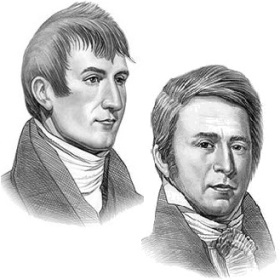|
The Journals
of Lewis and Clark: The Shrubs and Undergrowth
The following
excerpts are taken from entries of the Journals of Lewis
and Clark - Shrubs and Undergrowth. A general description
of the beasts, planys and Shrubs and Undergrowth, &c.
found by the party in this expedition.
The undergrowth consists
of honeysuckles, alder, seven bark or nine bark, huckleberry,
a shrub like the quill wood, a plant like the mountain-holley,
a green briar, the fern.
•1. The honeysuckle
common to the United States we found in this neighborhood.
We first discovered the honeysuckle on the waters of
the Kooskooskee, near the Chopunnish nation, and again
below the grand rapids.
•2. The alder which
is also common to our country, was found in great abundance
in the woodlands, on this side of the Rocky mountains.
It differs in the color of its berry: this being of
a pale sky blue, while that of the United States is
of a deep purple.
•3. The seven bark,
or, as it is usually denominated, the nine bark of the
United States, is also common to this country.
•4. The huckleberry.
There is a species of huckleberry, common to the highlands,
from the commencement of the Columblan valley to the
seacoast, rising to the height of six or eight feet,
branching and diffuse: the trunk is cylindrical, of
a dark brown color; the collateral branches are green,
smooth, and square, and put forth a number of alternate
branches of the same color, and from the two horizontal
sides only. The fruit is a small deep purple berry,
held in much esteem by the natives: the leaf is of a
pale green, and small, three-fourths of an inch in length,
and three-eights in width, oval, terminating more acutely
at the apex than at the insertion of the footstalk:
the base is nearly entire, and but slightly serrate:
the footstalks are short; their relative position is
alternate, two-ranked, and proceeding from the horizontal
sides of the boughs only.
•5. There are two
species of shrubs, first seen at the grand rapids of
the Columbia, and which have since been seen elsewhere:
they grow in rich dry grounds, usually in the neighborhood
of some water course: the roots are creeping and cylindrical:
the stem of the first species is from a foot to eighteen
inches in height, and about as large as an ordinary
goose quill: it is simple, unbranched, and erect: its
leaves are cauline, compound and spreading: the leaflets
are jointed, and oppositely pinnate, three pair, and
terminating in one sextile, widest at the base, and
tapering to an acuminate point: it is an inch and a
quarter in its greatest width, and three inches and
a quarter in length: each point of the margin is armed
with a subulate thorn, and from thirteen to seventeen
in number: are veined, glossy, carinated and wrinkled:
their points obliquely tending towards the extremity
of the common footstalk: the stem of the second species
is procumbent, about the size of that of the first species,
jointed and unbranched: its leaves are cauline, compound,
and oppositely pinnate: the rib is from fourteen to
sixteen inches in length, cylindric and smooth: the
leaflets are two inches and a half long, and one inch
wide, and of the greatest width half an inch form the
base: this they regularly surround, and from the same
point tapering to an acute apex: this is usually terminated
with a small subulate thorn: they are jointed and oppositely
pinnate, consisting of six pair, and terminating in
one: sessile, serrate, and ending in a small subulate
spire, from twenty-five to twenty-seven in number: they
are smooth, plain, and of a deep green, and allobliquely
tending towards the extremity of the footstalk: they
retain their green all winter.
The large leafed
thorn, has a leaf about two inches and a half long,
which is petiolate, and conjugate: the leaflets are
petiolate, acutely pointed, having their margins cut
with unequal and irregular incissures: the shrub, which
we had once mistaken for the large leafed thorn, resembled
the stem of that shrub, excepting the thorn: it bears
a large three headed leaf: the briar is of the class
polyandria, and order poligymnia: the flowers are single:
the peduncle long and cylindrical: the calyx is a perianth,
of one leaf, five cleft, and acutely pointed: the perianth
is proper, erect, inferior in both petals, and germen:
the corolla consists of five acute, pale scarlet petals,
inserted in the receptacle with a short and narrow cleft:
the corolla is smooth, moderately long, situated at
the base of the germen, permanent, and in shape resembling
a cup: the stamens and filaments are subulate, inserted
into the receptacle, unequal and bent inwards, concealing
the pystilium: the anther is two lobed and influted,
situated on the top of the filament of the pystilium:
the germ is conical, imbricated, superior, sessile and
short: the styles are short, compared with the stamen,
capillary smooth and obtuse: they are distributed over
the surface of the germ, and deciduous without any perceptible
stamen.
|

